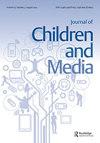Gender and parent–adolescent differences in perceived media parenting: Evidence from a Chinese validation study
IF 2.1
3区 心理学
Q2 COMMUNICATION
引用次数: 0
Abstract
ABSTRACT Parents and children often have different perceptions of parenting practices and we have limited knowledge on this issue regarding the media parenting practices. In this study, we aimed to examine the gender (male vs. female) and parent-adolescent differences in perceived media parenting in Chinese society. Adolescents (N = 737, Mean age = 14.71, SD = 1.40; 56.3% girls) and their parents (N = 702, 62.5% mothers) were sampled and invited to complete a newly developed Media Parenting Practices Scale (MPPS), resulting in a total of 486 matched families (with 272 girls and 293 mothers). The results confirmed the five latent constructs of MPPS with appropriate psychometric evidence: restriction, involvement, modeling, supervision, and reward. The between-group analysis identified significant gender differences in perceived media parenting between fathers and mothers and between boys and girls. The paired-sample t-test revealed significant parent – adolescent differences, with parents reporting significantly higher levels of media parenting practices than their adolescents. Impact Summary Prior State of Knowledge: Parents often use different strategies to mediate and mitigate the negative effects of the media in their children’s lives. However, there is still a lack of common terminologies to describe media parenting practices that address the recent media prevalence among adolescents. Moreover, it is also unknown whether there are significant gender differences (i.e., father-mother, boy-girl) and parent-adolescent regarding the media parenting practices. Novel Contributions: This study contributes a newly developed five-dimensional media parenting practices scale (MPPS), which includes restriction, involvement, modeling, supervision, and reward, and further reveals the differences in each sub-dimension between gender and parent-adolescent within the Chinese context. Practical Implications:This study has implications for scholars, parents, and their adolescents. On the one hand, the five-dimensional scale offers a new framework for them to examine media parenting behaviors. On the other hand, the differences found between gender and parent-adolescent called for further attention to the potential consequences.性别和父母-青少年在媒体育儿方面的差异:来自中国验证研究的证据
父母和孩子对父母教养方式往往有不同的看法,我们对媒体教养方式的认识有限。在本研究中,我们旨在探讨性别(男性与女性)和父母-青少年在中国社会感知媒体养育的差异。青少年(N = 737,平均年龄= 14.71,SD = 1.40;(56.3%的女孩)和她们的父母(N = 702, 62.5%的母亲)被抽样并邀请完成新开发的媒体养育实践量表(MPPS),总共有486个匹配的家庭(272个女孩和293个母亲)。结果用适当的心理测量证据证实了MPPS的五个潜在构念:限制、参与、建模、监督和奖励。组间分析发现,在父亲和母亲之间以及男孩和女孩之间,对媒体养育的感知存在显著的性别差异。配对样本t检验揭示了显著的父母与青少年之间的差异,父母报告的媒体育儿实践水平明显高于他们的青少年。影响总结先前的认知状态:父母经常使用不同的策略来调解和减轻媒体对孩子生活的负面影响。然而,仍然缺乏共同的术语来描述媒体育儿实践,以解决最近媒体在青少年中流行的问题。此外,媒体养育方式是否存在显著的性别差异(即父亲-母亲、男孩-女孩)和父母-青少年之间的差异也是未知的。新贡献:本研究编制了包括限制、参与、示范、监督和奖励在内的五维度媒体教养行为量表,并进一步揭示了中国背景下性别和父母-青少年在各维度上的差异。实际意义:本研究对学者、家长及青少年有启示意义。一方面,五维量表为他们研究媒体养育行为提供了一个新的框架。另一方面,性别和父母-青少年之间的差异需要进一步关注潜在的后果。
本文章由计算机程序翻译,如有差异,请以英文原文为准。
求助全文
约1分钟内获得全文
求助全文

 求助内容:
求助内容: 应助结果提醒方式:
应助结果提醒方式:


